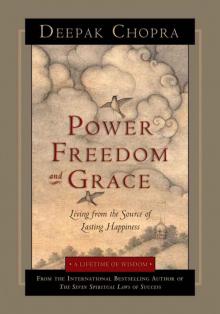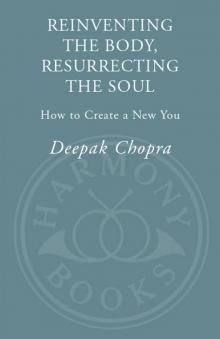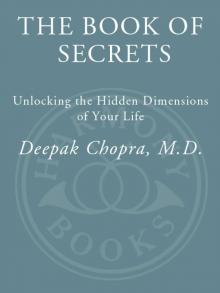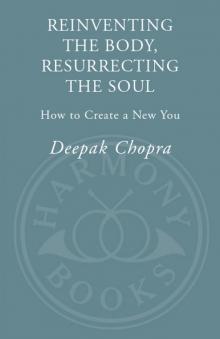- Home
- Deepak Chopra
The Book of Secrets: Unlocking the Hidden Dimensions of Your Life Page 13
The Book of Secrets: Unlocking the Hidden Dimensions of Your Life Read online
Page 13
Where did this runaway abuse come from? For comfort’s sake, we usually say that it exists in a few “bad apples,” but the Stanford experiment suggests something more disturbing: Evil exists in everyone as a shadow, for the very reason that the world is in everyone. Being raised as a good person is a counter to the shadow of evil, of course, and if we return to our list of shaping forces on consciousness, each person would exhibit a different map of influences. But if you are fortunate enough to have made choices on the good side of the equation, you must still acknowledge that the shadow exists in you somewhere.
The shadow was formed by the same everyday situations that shape our consciousness, and it is released by new situations that parallel them. If you were abused as a child, being around children can bring up those memories. The Stanford experimenters devised a list of conditions that cause people to do things we’d call evil, or at the very least alien to our true selves. I’ve expanded on it in light of what we know about dualism and separation.
INCUBATING EVIL
Conditions That Release Shadow Energies
Removing a sense of responsibility
Anonymity
Dehumanizing environments
Peer examples of bad behavior
Passive bystanders
Rigid levels of power
Prevailing chaos and disorder
Lack of meaning
Implicit permission to do harm
“Us-versus-them” mentality
Isolation
Lack of accountability
Again, are any of these conditions intrinsically evil? This list, as compared to the first, feels as if some evil component has entered. Leaving aside prisons, where one might expect the worst in human nature to emerge, as a physician I’ve seen similar abuse in hospital settings. Certainly, hospitals are not evil; they were established to do good in the first place. But the shadow isn’t about who is good or bad. It’s about sealed-up energies looking for an outlet, and a hospital is rife with the very conditions listed above: Patients are helpless under the authority of doctors and nurses; they are dehumanized by the cold mechanistic routine, isolated from everyday society, made more or less anonymous as one “case” among thousands, and so forth.
Given the right circumstances, everyone’s shadow energy will emerge.
Let’s focus, then, on the shadow as the area where consciousness has become distorted to the point that evil choices might be made. (Keep in mind the word “might,” since even under the most dehumanized conditions, there are good people who remain good, which is to say that they are able to resist or control the release of their shadow energies.) The famed Swiss psychologist C. G. Jung was the first to use “the shadow” as a clinical term, but here I want to speak in general of the hidden places where we all repress things we feel guilty about or ashamed of. I will call this place the shadow, and I believe there are certain true things to be said about it:
The shadow is personal and universal at the same time.
Anything can be stored there.
Whatever is stored in darkness becomes distorted.
The intensity of shadow energies is a way of getting noticed.
Bringing consciousness to any energy defuses it.
The shadow itself is not evil and therefore not your enemy.
By examining each statement, we get closer to removing the fearful demon we label—almost always in other people—as evil incarnate.
The shadow is personal and universal at the same time: Everyone harbors a unique pattern of shame and guilt. Simple things like nudity, sexual intercourse, anger, and anxiety give rise to enormously complex feelings. In one society, seeing your mother naked could be trivial, while in another it could be such a traumatic experience that it can only be dealt with by shoving it down into the shadow. There is no sharp distinction between personal feelings, family feelings, and social feelings. They blend and weave together. But even if you feel ashamed that you hit a bully on the playground when you were seven, and another person thinks doing the same thing was a valuable moment in developing personal courage, to have a shadow is universal as well as personal. The human psyche was set up with a hiding place, and for most people that place is totally necessary, given the enormous difficulty of facing one’s darkest impulses and deepest humiliations.
Anything can be stored there: A bank vault where you keep your most precious possessions is a hiding place as much as a prison dungeon. The same is true for the shadow. Although the term is used most of the time to describe a hiding place for negative energies, you have the power to turn positive to negative and vice versa. I once knew two sisters who were close as children but grew up as very different adults, the one a successful college professor, the other a twice-divorced worker at a temporary agency. The successful sister describes her childhood as wonderful; the other sister describes hers as traumatic. “Remember when Daddy locked you in the bathroom for six hours after you did something wrong?” I heard the unhappy sister say to her sibling. “That was a turning point for me. I could only imagine how angry and hopeless you felt.”
The happy sister looked very surprised. “Why didn’t you ask me about that? I liked being alone, so I just went inside and told myself imaginary stories. The incident was nothing.” And so our stories go their separate, highly idiosyncratic ways. The same incident had no emotional charge for one sister, whereas it was a source of anger and shame for the other. Great art can be made out of scenes of violence (witness Picasso’s Guernica) and horrors can be concocted from holy virtue (witness the crucifixion of Jesus). In the unconscious, there is a full population of unexamined impulses. The same Stanford student who might debase himself as a sadistic prison guard could also be harboring artistic talent that will never emerge unless the right situation allows the unconscious mind to release what it is holding.
Whatever is stored in darkness becomes distorted: Awareness, like fresh water, is meant to flow, and when it can’t, it turns stagnant. In your inner world, there are countless memories and repressed impulses. You do not allow these to flow, which is to say to be released; therefore, they have no choice but to stagnate. Good impulses die for lack of being acted on. Love grows timid and afraid when not expressed. Hatred and anxiety loom larger than life. It is the primary property of consciousness that it can organize itself into new patterns and designs. If you don’t allow consciousness to go where it needs to, however, disorganized energy is the result. For example, if you ask people to describe how they feel about their parents, a subject that most adults set aside as a thing of the past, you find that their memories from childhood are a confusing jumble. Trivial events stand out as huge traumas; other family members are simplified into cartoons; true feelings are hard or impossible to excavate. Thus, when a disturbed patient comes to a psychiatrist to be healed of a painful childhood wound, it often takes months if not years to separate fact from fantasy.
The intensity of shadow energies is a way of getting noticed: Hiding something is not the same as killing it. Shadow energies remain alive. Even though you refuse to look at them, they aren’t extinguished—in fact, their desire for life becomes all the more desperate. To catch your attention as a parent, a child who is overlooked will become more and more extreme in its behavior: first a call for attention, then a cry, then a tantrum. Shadow energies follow much the same pattern. It seems only reasonable to see panic attacks, for example, as a hidden fear throwing a tantrum. That same fear first called out to be noticed in a normal way, but when the person refused to notice it, a call turned into a cry and finally ended up as a full-blown attack. Fear and anger are especially adept at increasing the voltage to the point where we feel that they are alien, evil, demonic forces acting without our will. They are actually just aspects of consciousness forced into inhuman intensity by repression. Repression says, “If I don’t look at you, you will leave me alone.” To which the shadow answers, “I can do things that will make you look at me.”
Bringing consciousness to any energy d
efuses it: This follows naturally from the last statement. If an energy demands your attention, then paying attention will begin to satisfy it. An overlooked child isn’t placated by one glance. It takes time to change any behavior for good or ill and, like children, our shadow energies get stuck in patterns and habits. But this doesn’t alter the general truth that if you bring light into the shadow, its distortions start to lessen and eventually are healed. Is there time enough and patience to do the whole job thoroughly? There’s no fixed answer to that. Depression, for example, is a complex response that can be healed by insight, compassion, patience, caring attention from others, willingness, and professional therapy. Or you can take a pill and not bother. The choice is personal and varies from person to person. Conditions as apparently hopeless as childhood autism have been cured by parents who spent enormous amounts of time and attention to bring a child back from darkness. The darkness was a distortion in consciousness that needed light to be cured. The shadow in all its forms requires consciousness in the form of light and love, and the only limit to healing is how much of ourselves we are willing to give to the project.
The shadow itself is not evil and therefore not your enemy: If the preceding statements are true, then this one must be also. I realize that for many people there is a huge barrier in the form of “the other,” someone outside themselves whose evil is unquestioned. Sixty years ago “the other” lived in Germany and Japan; thirty years ago it lived in the Soviet Union; today it lives in the Middle East. Such people find evil easier to explain by never losing sight of “the other”—without an enemy, they would have to face the presence of evil inside themselves. How much more convenient it is to know in advance that you are on the side of the angels!
Seeing the shadow in yourself defuses the whole notion of “the other” and brings closer the statement of the Roman poet Terence: Nothing human is foreign to me. Can absolute evil be banished so quickly, however? Polls show that a majority of people believe in the existence of Satan, and many religious sects firmly believe that the devil is loose in the world, secretly changing history through his malignant doings. It doesn’t seem that good has a chance to conquer evil—perhaps their combat is eternal, never to be finally settled. But you can still choose the side you want to be on. That very fact removes the absolute from absolute evil, since by definition absolute evil would win every time, finding no obstacle in the frailty of human choice. Most people don’t accept this conclusion, however. They watch the drama of good and evil as if it and not they have the power, sitting mesmerized by pictures of the latest epidemic of crime, war, and disaster.
You and I as individuals can’t solve the problem of evil on a mass scale, and this sense of being powerless magnifies the belief that good in the end really isn’t going to win. But to grapple with evil, you have to look at it, not in horror or as spectacle but with the same attention that you’d give to any problem you are seriously interested in. Many people find it taboo to look at evil; the theme of most horror movies is that if you come too close, you get what you deserve. But the facts about personal evil are more mundane than horrifying. In all of us, there are impulses fueled by a sense of injustice. Or we feel that someone has done us unforgivable harm from which we harbor grudges and grievances.
When you have been treated unjustly or personally harmed, the natural emotion is anger. If this anger can’t get out, it festers and grows in the shadow. Lashing out when holding it back no longer works; this anger leads to a cycle of violence. Guilt can make you feel like a bad person simply for having an impulse or entertaining a thought. This is a kind of double bind: If you lash out and return the harm done to you, you have done something evil, but if you keep the anger inside and harbor it, you can feel just as evil.
Yet violence can be tamed by breaking it down into manageable bits. Negative emotions feed off certain aspects of the shadow that are very manageable:
The shadow is dark. Everyone has a shadow because of the natural contrast between darkness and the light.
The shadow is secret. We store impulses and feelings there that we wish to keep private.
The shadow is dangerous. Repressed feelings have the power to convince us that they can kill us or make us go insane.
The shadow is shrouded in myth. For generations, people have seen it as the lair of dragons and monsters.
The shadow is irrational. Its impulses fight against reason; they are explosive and totally willful.
The shadow is primitive. It’s beneath the dignity of a civilized person to explore this domain, which reeks of the smell of the charnel house, the prison, the lunatic asylum, and a public lavatory.
Negativity assumes its overwhelming power from the fact that it feeds off all these qualities at once: A secret, dark, primitive, irrational, dangerous, mythical evil is much less convincing if you break it down into one quality at a time. But this process of bringing evil down to scale won’t be convincing until you apply it to yourself.
So let’s do that. Take a volatile issue at this moment: terrorism. By any measure, to inflict terror on innocent people is an act of cowardly, despicable evil. Now pull closer. Imagine yourself so inflamed by intolerance and religious hatred that you’d be willing to kill. (If you find that terrorism isn’t charged enough for you personally, examine instead a feeling you might have based on racism, vengeance, or domestic abuse—any issue that creates a murderous impulse in you.)
No matter how evil your impulse is, it can be broken down into steps to resolve it:
Darkness: Ask yourself if it’s really you having this impulse, the you whom you see in the mirror every morning.
Darkness is dealt with by bringing in the light. Freud called this replacing Id with Ego, meaning that “It” (the unnamed thing inside us) needs to be gathered back into the realm of “I” (the person you know yourself to be). In simpler terms, awareness needs to go into the place where it has been shut out.
Secrecy: Confide your evil impulse to someone you trust.
Secrecy is dealt with by honestly facing things that seem shameful or guilty. You face any and every feeling head on, without denial.
Danger: Release your anger out loud, staying with it as it decreases. Have the intention that this release is not merely venting, but truly letting go of your rage.
Danger is dealt with by defusing the bomb; that is, you find the explosive anger that lurks inside and you dispel it. Anger is the primal drive of evil impulses. Like all impulses, it comes in varying degrees, and even a towering rage can be deflated until it defuses into controlled rage, then justified anger, and on down to righteous indignation, and finally personal offense. Personal offense is not difficult to dispel, once you manage to release the built-up intensity that turns into uncontrollable rage.
Myth: Name a hero who would deal with your feelings in a different way and still remain heroic. Violence is part of heroism but so are many other positive qualities.
Myth is imaginative and creative. Therefore you can take any myth and mold it along different lines—Satan himself becomes a comic figure in medieval miracle plays, a ploy that leads directly to the comic villains in James Bond films. Myth is nothing but metamorphosis; therefore, this level gives us a powerful way to turn demons into helpers of the gods, or defeated enemies of the angels.
Irrationality: Come up with the best argument for not acting on your rage. Don’t do this emotionally: See yourself as an adult counselor of a wayward teenager about to ruin his life. What would you say to make him see reason?
Irrationality is dealt with by persuasion and logic. Emotions are much more gripping and powerful than reason, but they will not be able to escape their world, where only feelings prevail, until the thinking process gives them a reason to feel differently. On their own, without mind, feelings remain the same and grow more intense over time. (A common example: Imagine yourself enraged because a kid in a red baseball cap keyed your car. He runs away and escapes. The next day you see him and run up, but when he turns around, it’s
a different kid. Rage turns into apology because the mind was able to introduce a simple idea: wrong person.)
Primitiveness: Without excuses or rationalizations, express your rage like a beast on a rampage—growling, howling, writhing, letting your body go. Let what’s primitive be primitive, within safe bounds.
Primitive feelings are dealt with at their own level, as holdovers of the lower brain. You remove the disguise of being civilized. This level of awareness runs even deeper than emotion—the very most primitive area, known as the reptilian brain, interprets all stress as a life or death struggle for survival. At this level, your “reasonable” sense of injustice is experienced as blind panic and blind ferocity.
Even though your impulses may never cross the line into violence, ordinary impulses intensify in the shadow, where you can’t see them. Whenever you hear yourself sounding resentful or angry without provocation, whenever you find yourself on the verge of tears for no reason, whenever you cannot explain why you suddenly made a rash decision, you are actually feeling the effects of energy covertly building up in the shadow.
The shadow has grown used to being repressed; therefore, to access this region of the mind doesn’t happen easily. Nor is direct assault effective. The shadow knows how to resist; it can slam the door and hide its dark energy even deeper. If you recall the concept of catharsis from Greek tragedy, it was thought that only by deeply frightening the audience could they open up and feel pity. Catharsis is a form of purification. In this case it was arrived at second-hand, by having the audience see fearful actions in the life of a character on stage. But this form of trickery doesn’t always work. You can go to a horror film today and come out of the theater completely unmoved, the higher brain muttering, “I’ve seen those special effects before.” (In the same way, televised news, after fifty years of displaying gruesome images of war and violence, has done little more than inure its viewers to such images, or worse, turned them into entertainment.) Discharge is natural to the body, however, and simply by observing these shadow energies, we give them access to the conscious level of the mind.

 Muhammad: A Story of the Last Prophet
Muhammad: A Story of the Last Prophet Buddha
Buddha Power, Freedom, and Grace
Power, Freedom, and Grace Reinventing the Body, Resurrecting the Soul: How to Create a New You
Reinventing the Body, Resurrecting the Soul: How to Create a New You The Book of Secrets: Unlocking the Hidden Dimensions of Your Life
The Book of Secrets: Unlocking the Hidden Dimensions of Your Life Muhammad
Muhammad Reinventing the Body, Resurrecting the Soul
Reinventing the Body, Resurrecting the Soul